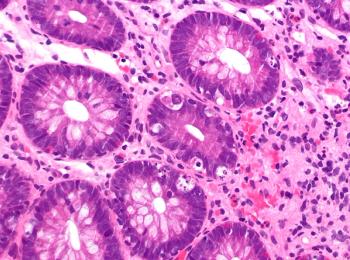
- Oncology Vol 30 No 8
- Volume 30
- Issue 8
Precision Monitoring by Next-Generation Sequencing in Lymphoma: Circulating Tumor DNA as a New Biomarker
It is clear that as our understanding of both aggressive and indolent lymphomas improves, the goals of treatment change and the bar for success is set higher.
In this review, Drs. Melani and Roschewski discuss the current state of molecular-based prediction of outcomes and monitoring of patients with lymphoma before, during, and after treatment.[1] They outline novel techniques based on a better understanding of the biology of lymphoma and on the availability of new technology that allows deeper investigation of minimal residual disease (MRD), as well as identification of relevant mutations that can be detected in the peripheral blood. This approach has the potential to change the paradigm for the management of patients with lymphomas and ultimately to improve outcomes. In aggressive lymphomas that we consider curable, measurement of circulating tumor DNA (ctDNA) in blood (“liquid biopsy”) may be used to detect minimal residual disease (MRD) and thus allow for alternate therapy; measurement of ctDNA also may alter the approach for indolent lymphomas-by allowing “selective maintenance” in patients who exhibit MRD recurrence before disease is detectable by physical examination or imaging.
It is clear that as our understanding of both aggressive and indolent lymphomas improves, the goals of treatment change and the bar for success is set higher. Numerous studies have tried to identify biomarkers that will allow for more successful outcomes and predict treatment failure and early relapse. In diffuse large B-cell lymphoma (DLBCL), most of the biomarkers to date have been clinical, relying either on patient characteristics, such as age and performance status, or on tumor characteristics, such as serum lactate dehydrogenase level and number of extranodal sites. These biomarkers informed the original International Prognostic Index (IPI),[2] and subsequent iterations of the IPI have resulted in fine-tuning.[3-6] Similarly, prognostic indices in mantle cell lymphoma[7-10] and in chronic lymphocytic leukemia[11] have evolved as predictors of outcome and guides to clinical trial interpretation. In follicular lymphoma, the Follicular Lymphoma International Prognostic Index (FLIPI) and FLIPI 2 scores have emerged and provided prognostic information,[12-14] and in classical Hodgkin lymphoma, the International Prognostic Score and its evolution in the last decade have allowed us to better understand and predict the clinical course in this heterogeneous disease.[15-17] Other biomarkers, which are based upon molecular profiles at the time of diagnosis, also exist for classical Hodgkin lymphoma.[18-20]
It has recently been recognized that perhaps more important than assessing the initial clinical or biologic features in a cohort of patients is assessment of the response to our best treatment in each individual patient. It was with that aim in mind that the concept of interim imaging techniques began to gain a foothold. Recent studies in classical Hodgkin lymphoma have identified the interim positron emission tomography (PET) scan as a new biomarker, since it turns out to be a major predictor of response. Recent data suggest that PET findings may serve as a signal to change chemotherapy regimens or to include or eliminate alternate therapeutic modalities such as radiation.[21,22] Similar studies have now been completed in DLBCL.[23]
As our technology has evolved, we are presented with the prospect of increasingly sensitive and possibly more accurate and predictive tools and models for managing patients with lymphoma and other malignancies. The concept of using
ctDNA levels to monitor a malignancy is not new, and the utility of this approach has been discussed and reviewed in the literature, albeit mostly in solid tumors.[24-26] However, in lymphoid tumors, we are now able to take advantage of our understanding of lymphoid biology, so the ability to identify the variable, diversity, and joining (VDJ) regions of immunoglobulin receptors has provided a very sensitive and specific method for detection of ctDNA in peripheral blood. This has come about because our ability to combine universal polymerase chain reaction primers with next-generation sequencing (NGS) has made it possible to detect both ctDNA and tumor-specific mutations (eg, c-MYC,CARD11, and MYD88) in DLBCL.[27] Work by Kurtz,[28] Alizadeh,[29] and Hohaus[30,31] has suggested that the detection of ctDNA with NGS-based assays can serve as our newest and possibly our most reliable biomarker. It is imperative, however, that this approach be compared against the existing clinical and biologic parameters upon which we have relied for decades.
The precision and the noninvasive quantitative nature of the techniques described by Melani and Roschewski, and their ability to detect clonotypic evolution in lymphoma, make them appealing for broad clinical use. This technology holds great promise for improving outcomes by making it possible to design treatment strategies using a rational and scientifically based approach.
Financial Disclosure:The author has no significant financial interest in or other relationship with the manufacturer of any product or provider of any service mentioned in this article.
References:
1. Melani C, Roschewski M. Molecular monitoring of cell-free circulating tumor DNA in non-Hodgkin lymphoma. Oncology (Williston Park). 2016;30:731-8, 744.
2. The International Non-Hodgkin’s Lymphoma Prognostic Factors Project. A predictive model for aggressive non-Hodgkin’s lymphoma. N Engl J Med. 1993;329:987-94.
3. Gordon LI, Andersen J, Colgan J, et al. Advanced diffuse non-Hodgkin’s lymphoma. Analysis of prognostic factors by the International Index and by lactic dehydrogenase in an intergroup study. Cancer. 1995;75:865-73.
4. Zhou Z, Sehn LH, Rademaker AW, et al. An enhanced International Prognostic Index (NCCN-IPI) for patients with diffuse large B-cell lymphoma treated in the rituximab era. Blood. 2014;123:837-42.
5. Ozturk E, Ozbalak M, Berk S, et al. Comparison of International Prognostic Index and NCCN-IPI in 324 patients with de novo diffuse large B-cell lymphoma: a multi-center retrospective analysis. Leuk Lymphoma. 2016;57:1211-4.
6. Hamlin PA, Zelenetz AD, Kewalramani T, et al. Age-adjusted International Prognostic Index predicts autologous stem cell transplantation outcome for patients with relapsed or primary refractory diffuse large B-cell lymphoma. Blood. 2003;102:1989-96.
7. Budde LE, Guthrie KA, Till BG, et al. Mantle Cell Lymphoma International Prognostic Index but not pretransplantation induction regimen predicts survival for patients with mantle-cell lymphoma receiving high-dose therapy and autologous stem-cell transplantation. J Clin Oncol. 2011;29:3023-9.
8. Hoster E, Klapper W, Hermine O, et al. Confirmation of the Mantle-Cell Lymphoma International Prognostic Index in randomized trials of the European Mantle-Cell Lymphoma Network. J Clin Oncol. 2014;32:1338-46.
9. Geisler CH, Kolstad A, Laurell A, et al. The Mantle Cell Lymphoma International Prognostic Index (MIPI) is superior to the International Prognostic Index (IPI) in predicting survival following intensive first-line immunochemotherapy and autologous stem cell transplantation (ASCT). Blood. 2010;115:1530-3.
10. Eve HE, Gambell J, Smith P, et al. The Simplified Mantle-Cell Lymphoma International Prognostic Index predicts overall survival but not progression-free survival in patients with mantle-cell lymphoma treated with fludarabine and cyclophosphamide +/- rituximab: results of a randomized phase II trial. Leuk Lymphoma. 2009;50:1709-11.
11. The International CLL-IPI Working Group. An international prognostic index for patients with chronic lymphocytic leukemia (CLL-IPI): a meta-analysis of individual patient data. Lancet Oncol. 2016;17:779-90.
12. Solal-Celigny P, Roy P, Colombat P, et al. Follicular Lymphoma International Prognostic Index. Blood. 2004;104:1258-65.
13. Federico M, Bellei M, Marcheselli L, et al. Follicular Lymphoma International Prognostic Index 2: a new prognostic index for follicular lymphoma developed by the International Follicular Lymphoma Prognostic Factor Project. J Clin Oncol. 2009;27:4555-62.
14. Nooka AK, Nabhan C, Zhou X, et al. Examination of the Follicular Lymphoma International Prognostic Index (FLIPI) in the National LymphoCare study (NLCS): a prospective US patient cohort treated predominantly in community practices. Ann Oncol. 2013;24:441-8.
15. Josting A, Franklin J, May M, et al. New prognostic score based on treatment outcome of patients with relapsed Hodgkin’s lymphoma registered in the database of the German Hodgkin’s lymphoma study group. J Clin Oncol. 2002;20:221-30.
16. Moccia AA, Donaldson J, Chhanabhai M, et al. International Prognostic Score in advanced-stage Hodgkin’s lymphoma: altered utility in the modern era. J Clin Oncol. 2012;30:3383-8.
17. Diefenbach CS, Li H, Hong F, et al. Evaluation of the International Prognostic Score (IPS-7) and a Simpler Prognostic Score (IPS-3) for advanced Hodgkin lymphoma in the modern era. Br J Haematol. 2015;171:530-8.
18. Scott DW, Chan FC, Hong F, et al. Gene expression-based model using formalin-fixed paraffin-embedded biopsies predicts overall survival in advanced-stage classical Hodgkin lymphoma. J Clin Oncol. 2013;31:692-700.
19. Steidl C, Diepstra A, Lee T, et al. Gene expression profiling of microdissected Hodgkin Reed-Sternberg cells correlates with treatment outcome in classical Hodgkin lymphoma. Blood. 2012;120:3530-40.
20. Tan KL, Scott DW, Hong F, et al. Tumor-associated macrophages predict inferior outcomes in classic Hodgkin lymphoma: a correlative study from the E2496 Intergroup trial. Blood. 2012;120:3280-7.
21. Radford J, Illidge T, Barrington S. PET-directed therapy for Hodgkin’s lymphoma. N Engl J Med. 2015;373:392.
22. Barrington SF, Kirkwood AA, Franceschetto A, et al. PET-CT for staging and early response: results from the Response-Adapted Therapy in Advanced Hodgkin Lymphoma study. Blood. 2016;127:1531-8.
23. Press OW, Li H, Schoder H, et al. US intergroup trial of response-adapted therapy for stage III to IV Hodgkin lymphoma using early interim fluorodeoxyglucose-positron emission tomography imaging: Southwest Oncology Group S0816. J Clin Oncol. 2016;34:2020-7.
24. Liao W, Yang H, Xu H, et al. Noninvasive detection of tumor-associated mutations from circulating cell-free DNA in hepatocellular carcinoma patients by targeted deep sequencing. Oncotarget. 2016 May 26. [Epub ahead of print]
25. Riva F, Dronov OI, Khomenko DI, et al. Clinical applications of circulating tumor DNA and circulating tumor cells in pancreatic cancer. Mol Oncol. 2016;10:481-93.
26. Leung F, Kulasingam V, Diamandis EP, et al. Circulating tumor DNA as a cancer biomarker: fact or fiction? Clin Chem. 2016 Jun 3. [Epub ahead of print]
27. Roschewski M, Staudt LM, Wilson WH. Dynamic monitoring of circulating tumor DNA in non-Hodgkin lymphoma. Blood. 2016;127:3127-32.
28. Kurtz DM, Green MR, Bratman SV, et al. Noninvasive monitoring of diffuse large B-cell lymphoma by immunoglobulin high-throughput sequencing. Blood. 2015;125:3679-87.
29. Alizadeh AA, Aranda V, Bardelli A, et al. Toward understanding and exploiting tumor heterogeneity. Nat Med. 2015;21:846-53.
30. Hohaus S, Giachelia M, Massini G, et al. Cell-free circulating DNA in Hodgkin’s and non-Hodgkin’s lymphomas. Ann Oncol. 2009;20:1408-13.
31. Hohaus S. Genomic imbalances in circulating DNA in Hodgkin’s lymphoma. Lancet Haematol. 2015;2:e48-e49.
Articles in this issue
over 9 years ago
The Clinical Problem of Chemotherapy-Induced Nausea and Vomitingover 9 years ago
Management of Leptomeningeal Disease From Solid Tumorsover 9 years ago
Optimal Use of Bone-Targeted Agents in Breast CancerNewsletter
Stay up to date on recent advances in the multidisciplinary approach to cancer.

















































































